 |
 |
 |
| |
48 Week Efficacy and Safety of MK-0518, a Novel HIV-1 Integrase Inhibitor, in Patients with Triple-Class Resistant Virus, Phase II Protocol 005
|
| |
| |
Reported by Jules Levin
ICAAC Sept 17-20, 2007, Chicago
AUTHOR CONCLUSIONS
In HIV-1 infected patients failing therapy with triple-class resistant virus, raltegravir in combination with optimized background therapy:
--has potent, superior, and durable antiretroviral activity:
64-71% of patients had HIV-RNA <400 copies/ml at week 48
46-64% of patients had HIV RNA <50 copies/ml at week 48.
Generally well tolerated; with very few adverse experiences leading to discontinuations
BACKGROUND for RALTEGRAVIR (MK-0518, ISENTRESS)- HIV-1 Integrase Inhibitor
In Vitro activity
potent: IC95 = 31 nM ± 20 nM (50% human serum)
active against:
--multi-drug resistant HIV-1
--CCCR5 and CXCR4 HIV-1
HIV resistant to raltegravir remain sensitive to other ARVs
Additive/synergistic with NRTIs, NNRTIs, PIs, and Fuzeon
Combination Therapy:
--durable efficacy in ART-na´ve patients: 83-88% with HIV-RNA <50 c/ml at week 48 (Markowitz et al, JAIDS 2007, ePub 06 Sept07)
--Patients failing therapy with triple-class resistant virus: 56%-67% with HIV-RNA <50 c/ml at week 24. (Grinsztejn et al, Lancet 2007; 369:1261-69)
Protocol 005 Study Design
Phase II, randomized, double-blind, dose-ranging study in patients failing therapy with triple-class resistant virus, HIV-RNA >5000 copies/ml and CD4 >50, evaluating:
Raltegravir 200, 400, and 600 mg BID vs Placebo: all in combination with optimized background therapy (OBT)
Primary Endpoints:
Change from baseline in HIV RNA and safety at week 24
Secondary efficacy endpoints include:
- % with HIV RNA <400 c/ml
- % with HIV RNA <50 c/ml
- Change from baseline in CD4 cell counts
- Time to loss of virologic response (TLOVR)
When 400 mg BID was selected as Phase III dose, the protocol was amended to allow all patients to receive open-label(OL) raltegravir 400 mg BID after reaching at least week 24, the primary time point.
Patients with virologic failure after 16 weeks or more of double-blind therapy could enter an open-label post-virologic failure raltegravir arm )OLPVF) (data not shown).
This presentation focuses on the week 48 data from the double-blind (DB) and open-label (OL) phases:
--the median duration of the DB phase is 40 weeks for the raltegravir groups and 24 weeks for the placebo group
--At week 48, >85% of patients have switched to receive open-label rategravir or discontinued randomized therapy.
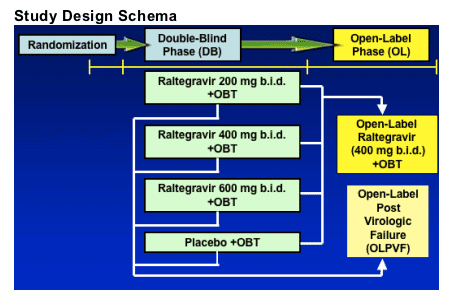
Patient Disposition
43-45 patients were treated in each of the 3 raltegravir dose arms and 45 in placebo in the double-blind phase. Discontinued DB: 13 (30%) in RAL 200mg, 14 (31%) in RAL 400mg, and 12 (27%) in RAL 600mg; for lack of efficacy 31% in RAL 400mg, 26% in RAL 200mg, and 24% in RAL 600mg. Entered OLPVF: all of the patients but 1 who discontinued due to lack of efficacy. Discontinued DB due to Adverse Experience: 2 (5%) in RAL 200mg, 0 in RAL 400mg, and 1 (2%) in RAL Placebo.
OPEN-LABEL (OL) PHASE:
30 patients entered RAL 200mg, 31 400mg RAL, and 33 RAL 600mg. Disconyinued OL due to AE: 0 in 200mg, 1(2%) in 400mg, and 0 in 600mg.
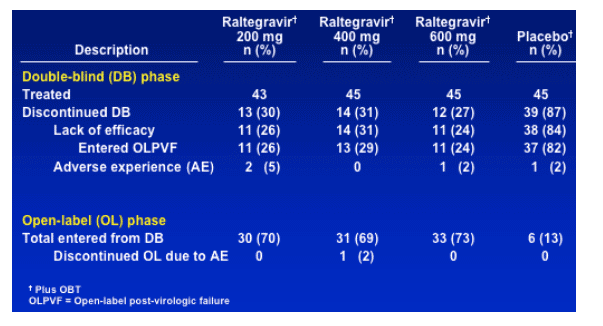
Patient and OBT Characteristics
Mean CD4 count: 220-245 in raltegravir groups and 274 in placebo.
Mean HIV RNA: 4.6-4.8 log copies/ml in raltegravir groups and 4.7 in placebo.
Median years of prior ART: 9-11 in all groups
OBT: Median # of ARTs - 4 in each of the arms
GSS: 0 to all ARTs - 63% in 200mg, 84% in 400mg, 78% in 600mg, 62% in PLB.
PSS: 0 to all ARTs - 47% in 200mg, 58% in 400mg, 49% in 600mg, 40% in PLB.
PSS: 0 to PI - 98% in 200mg, 93% in 400mg, 89% in 600mg, 84% in PLB.
% of pts with Fuzeon as new OBT: 30% in 200mg, 18% in 400mg, 29% in 600mg, 22% in PLB.
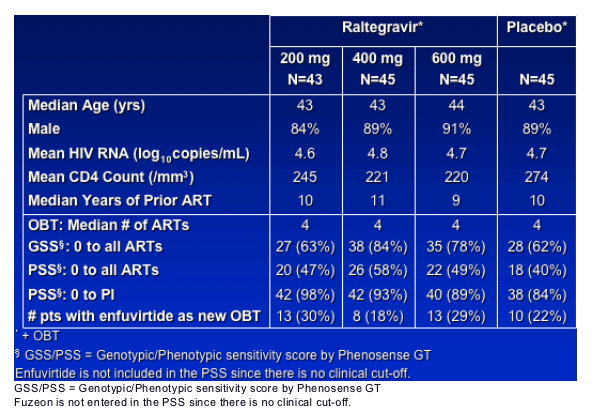
Percent of Patients (95% CI) with HIV RNA <400 copies/ml and <50 copies/ml
The type is hard to read since its in black, but the graph on the left is % <400 at week 24 and the in open-label from week 24-48, The graph on the right is % <50 c/ml up to week 24 and the open-label from week 24-48.
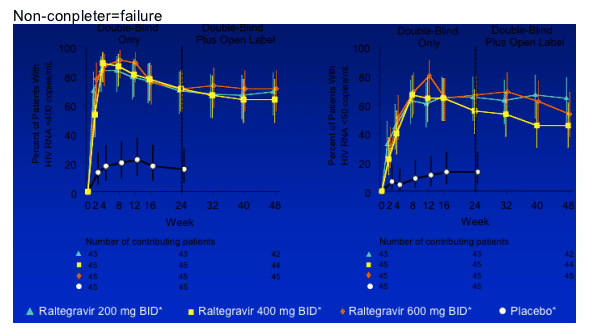
Mean Change ((%% CI) from Baseline in log10 HIV RNA and CD4 Cell Count
The graph on the left shows change in HIV RNA: there is an approximate -2.2 log reduction early by week 2-3, by week 24 its about -1.9 log, and about 1.7 at week 48. This is a very experienced population of patients and it does not appear that darunavir or tipranavir were available for this study. The graph on the right shows CD4 increases which are about a 100 cell increase for 400 & 600mg RAL arms, and about 50 for the RAL 400mg arm, compared to 0 for placebo.
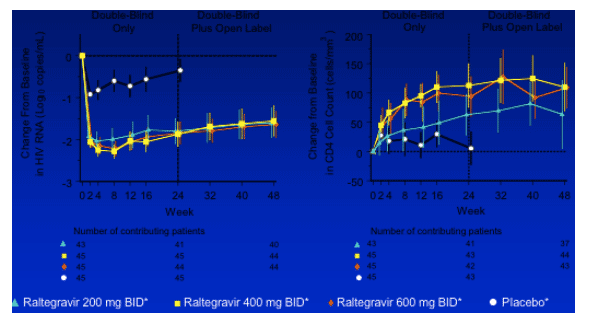
Time To Loss of Virologic Response to week 72 Raltegravir All Doses Combined vs Placebo
Patients who never achieved HIV RNA <400 c/ml were considered failures. Non-responders assigned failure at time 0.

RALTEGRAVIR RESISTANCE
From Hazuda et all, 16th Intl HIV Drug Resistance Workshop 2007 Barbados.
Most patients failing raltegravir (35/38) had integrase mutations conferring raltegravir mutations. Integrase mutations were in either of two genetic pathways (N155 or Q148 in 34 of 35 patients. Resistance was typically associated with 2 or more mutations (31 of 35 patients): Q148H/G140S was most common (n=13)
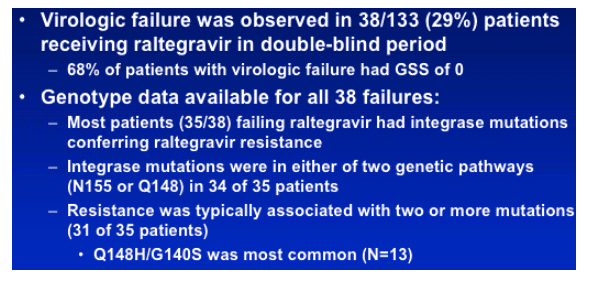
Analysis of Raltegravir Resistance
There was no association between dose and/or drug concentration and resistance.
Factors decreasing likelihood of developing mutations at amino acids 148 alone, 155 alone, either 148 or 155:
--lower viral load (<100,000 c/ml vs >100,000 c/ml)
-- new use of Fuzeon in OBT
--PSS>0
SAFETY During Double-Blind Study Period
Most clinical adverse events were mild to moderate.
Liver function test abnormalities uncommon:
--no grade 4 abnormalities for AST, ALT, Alk phosphatase
--grade 3 AST: 2/133 (1.5% in all RAL groups
--grade 3 ALT: 1/133 patients (0.8%) in all RAL groups
4 serious, drug-related clinical AEs:
--acute pancreatitis after 2 doses, considered (I think it says due to) OBT 200mg)
--matebolic acidosis and renal insufficiency (600mg); sepsis; death
--lacunar infarction by CT (placebo)
--worsening lipoatrophy (placebo)
2 discontinuations die to drug-related AE
--elevated AST/ALT (200mg) considered I think it says due to OBT
--lipoatrophy (placebo)
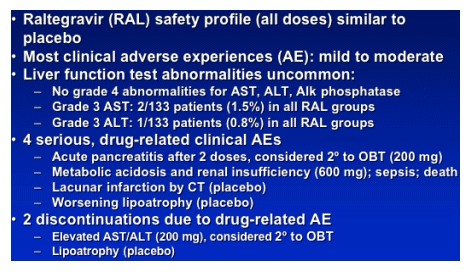
Drug-Related Clinical AEs - Double-Blind Study Period
(incidence >/= 5% in >/= one treatment group)
Safety profile for entire study period simikar to double-blind phase.
0 malignancy in DB/OL phases; 2 patients in OLPVF arm: worsening Hodgkin's; Hodgkin's and basal cell carcinoma.
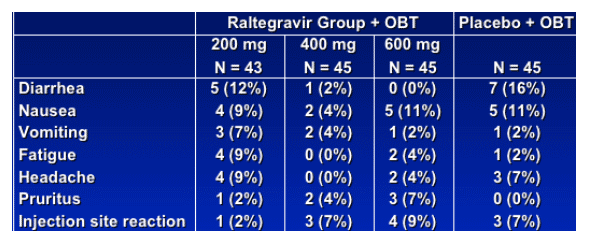
|
| |
|
 |
 |
|
|